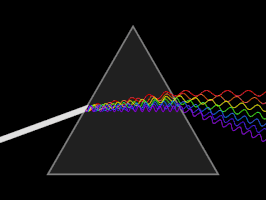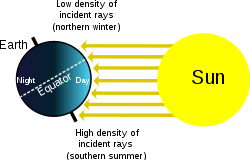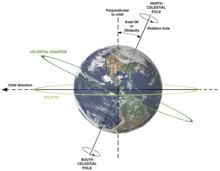Climatology/Insolation




Solar irradiance (SI) is the power per unit area received from the Sun in the form of electromagnetic radiation as reported in the wavelength range of the measuring instrument. This integrated solar irradiance is called solar irradiation, solar exposure, solar insolation, or insolation.The sun is the primary source of energy for the earth. The sun radiates its energy in all directions into space in short wavelengths, which is known as solar radiation.
- The earth’s surface receives only a part of this radiated energy (2 units out of 1,000,000,000 units of energy radiated by the sun).
- The energy received by the earth’s surface in the form of short waves is termed as Incoming Solar Radiation or Insolation.
- The amount of insolation received on the earth’s surface is far less than that is radiated from the sun because of the small size of the earth and its distance from the sun.
- Moreover, water vapour, dust particles, ozone and other gases present in the atmosphere absorb a small amount of solar radiation.
- The solar radiation received at the top of the atmosphere varies slightly in a year due to the variations in the distance between the earth and the sun.
- During the earth’s revolution around the sun, the earth is farthest from the sun on 4th July. This position of the earth is called aphelion. On 3rd January, the earth is nearest to the sun. This position is called perihelion.
- Due to this variation in the distance between the earth and the sun, the annual insolation received by the earth on 3rd January is slightly more than the amount received on 4th July.
- However, the effect of this variation is masked by some other factors like the distribution of land and sea and the atmospheric circulation. Hence the variation does not have a greater effect on daily weather changes on the surface of the earth.
Methods of Solar Energy Receipt[edit | edit source]
The solar radiation received by the earth’s atmosphere and surface by direct radiation or diffuse energy. There are five way of solar radiations. They are:--
- Transmission
- Scattering
- Refraction
- Absorption
- Reflection
Transmission[edit | edit source]
When the solar radiation reaches to the earth surface through a medium is known as transmission of solar radiation. The dictionary meaning of transmission is the passage of shortwave and longwave energy (electro-magnetic energy) through either the atmosphere or water but the sun’s energy is reaching to the earth without any medium from the space. It is also known as radiation. The atmospheric energy comprises shortwave radiation inputs (ultraviolet light, visible light, and near-infrared wavelengths) and longwave radiation outputs (thermal infrared) that pass through the atmosphere by transmission. In our atmosphere, all the radiation is not reaching to the earth surface or in other word, atmosphere is not opaque for all the radiation. This differential transmission causes the greenhouse effect in the atmosphere.Due to greenhouse effect of the atmosphere, the earth’s atmospheric temperature is hospitable. Without this effect, the living conditions could not be created.

Scattering[edit | edit source]
Atmospheric gases and dust particles physically interact with incoming solar radiations through processes of scattering. A redirection of energy through refraction and reflections called scattering. The solid particles of dust, smoke, aerosols, sea salts sprays, pollutants atmospheric humidity, smoke shoots etc. available in the atmosphere are responsible for scattering of sun electromagnetic energy. It changes the direction of the light's movement without altering its wavelengths. This phenomenon is known as scattering and represents 7percent of Earth's reflectivity, or albedo. It is ‘unpredictable’ because of multiple reflections of electromagnetic waves by particles and surfaces. But inreflection, the direction of reflection is predictable. Dust particles, pollutants, ice, cloud droplets, and water vapor produce further scattering.

Refraction[edit | edit source]
Refraction means bending of light. As solar radiation enters the atmosphere, it passes from one medium to another of atmosphere, from virtually empty space into atmospheric gases. The atmosphere itself is made up of different layers. The different layers have different density and change in density of the atmosphere causes the bending of incoming solar radiations at different angles. This refraction could also be seen with water as well. Itis known as refractionof incoming radiation. For example, prism refracts light passing through it, bending different wavelengths to different angles, separating the light into different component of colours to display the spectrum. In nature, rainbow is created when visible light passes through many raindrops and is refracted and reflected toward the viewer at a precise angle.

Reflection[edit | edit source]
The reflection is an ability of the material where a portion of arriving energy strikes. Depending upon the surface characteristics, where it strikes, the quantum of reflectivity is determined. It might be completely bounced directly back into space with or without being absorbed. This returned energy is called reflection especially specular reflectance where angle of incidence and angle of reflectance is same. A mirror is one of the example of reflecting more than 90 per cent of the visible light incidence upon it. The term albedo is used to describe the amount of energy reflected back in percentage. Albedo is the reflective quality of a surface. It is an important control over the amount of insolation that is available for absorption by a surface. So,the proportion of insolation that is reflected back from the atmosphere, from the tops of the clouds, and earth surface including land and water both, without heating the receiving surface, is an albedo.
Absorption[edit | edit source]
In our earth’s atmosphere due to the different composition, act as a barrier to the insolation or it absorbed some solar radiation, may be assimilated by the object is generally termed as atmospheric absorption. The different material on earth has different absorptive capabilities with different wavelength of solar radiation. It is happening in all electromagnetic radiations at certain spectral bands by the composition present in the atmosphere. The most efficient absorbers of solar radiation in this regardare water (H2O), carbon dioxide (CO2), ozone (O3), Oxygen (O2),nitrous oxide (NO2). The cumulative effect of the absorption by the various constituents can cause the atmosphere to close down completely in certain regions of the spectrum that leads to an increase in temperature. Generally, a good radiator is also a good absorber and a poor radiator is a poor absorber. As colour is concern, dark-colour surface are much more efficient absorbers of radiation in the visible portion of the spectrum than light-colour surface.
Factors Influencing Insolation[edit | edit source]
The amount of insolation received on the earth’s surface is not uniform everywhere. It varies according to the place and time. When the tropical regions receive maximum annual insolation, it gradually decreases towards the poles. Insolation is more in summers and less in winters. The major factors which influence the amount of insolation received are:--
- Solar output /constant
- The angle of incidence of the sun’s rays
- Duration of the day
- Earth distance from sun
- Transparency of the atmosphere

Solar output /constant[edit | edit source]

At the top of the earth’s atmosphere receives insolation is expressed as the solar constant.It received at the top of the atmospheric surface (thermopause) on a perpendicular plane to the solar beam. The average insolation received at the thermopause i.e. 1368Wm2(Watt per square metre)energy (solar constant) in the form of short wave. Thus, it is termed as solar constant for that mean distance from the sun. These solar constant is varying over 1 Wm2by periodic disturbances and explosions in the solar surface basically related to sun spot. Sun spots are dark and cooler areas visible on the sun’s surface. The recent researches have shown that more and more energy is released when the sunspots are in large number. The number of sunspots also increases or decreases on a regular basis, creating a cycle of 11 years.
The Angle of Incidence[edit | edit source]

Since the earth is a geoid resembling a sphere, the sun’s rays strike the surface at different angles at different places. This depends on the latitude of the place.The higher the latitude, the less is the angle they make with the surface of the earth. The area covered by the vertical rays is always less than the slant rays. If more area is covered, the energy gets distributed and the net energy received per unit area decreases.The sun’s rays with small angle traverse more of the atmosphere than rays striking at a large angle. The angle at which sun rays strike on earth surface is called angle of incidence. Itcontrols the amount of insolation received at the earth’s surface. The amount of insolation is determined by time of the day (morning, noon and evening), the latitude (equator to poles) and season (summer, autumn, winter and spring).When the sun rays strike vertically or sun is directly overhead, the rays angle of incidence is 90 degree. The beam of rays spread on a smaller area in comparison to oblique/ slanting beam of sun rays.when sun is in a vertical position, the beam of light will spread over one mile but in the oblique position(with 300of angle) of the sun the same beam of light will spread over two miles.It is clear that the larger amount of radiant energy is lost in case of slanting rays than in vertical rays. Therefore, on anaverage, equatorial areas receive approximately 2.4 times more insolation than polar areas.
Duration of The Day[edit | edit source]
The length of the day determines the duration of sunlight which affects the amount of solar radiation received by the earth’s surface. The longer period of sunshine, greater the quantity of solar radiation will be received by a portion of earth.For example, at the equator the length of days and nights is 12 hours in all the months but the tropics of Arctic and Antarctic sunshine duration varies between 0 and 24. On the autumn and springe quinoxes (September 23and March 21 respectively),the sun is overhead at the equatorat noon.The night and day all over the earth are equal on these days and maximum amount of insolation is received at the equator, and the amount of insolation decreasing towards the poles.It is caused by vertical sunshine at equator but with increasing latitudes, the rays become more and more slanting. Therefore, poleward, the received energy keeps on declining.
Earth Distance from Sun[edit | edit source]

The earth is revolving around the sun in an elliptical orbit, resulting continuous change in the distance between sun and the earth on annual basis. It leads to seasonal variation in solar energy received by the earth.The mean distance between the earth and sun is about 149,600,000 kilometers(92,900,000 miles). When earth position is farthest(152 million km) from sun is known as ‘aphelion’ on July 4. It is perihelion(147 million km)occurs on January 3 each year which is the closest distance. During aphelion the northern hemisphere is facing the sun and therefore receives energy about 7 percent less than the perihelion (southern hemisphere).
Transparency of the Atmosphere[edit | edit source]
Atmosphere is not transparent for all the radiation coming from the sun because of different composition and layers. It is also one of the controlling factors of insolation to reach earth surface. The atmosphere is composed of gases, water vapour and particulate matters.The atmosphere is a mixture of gases, such as nitrogen(N), oxygen (O2), Argon, carbon dioxide, Neon (Ne), Helium (He), Methane (CH4), Krypton (Kr), Ozone (O3), Nitrous oxide (N2O), Hydrogen (H) and Xenon (Xe). The atmosphere also contains water vapour, water in the gaseous state.
Mechanisms of Heating and Cooling of Atmosphere[edit | edit source]
Heating and cooling of theatmosphere is performed by following processes:--
- Partial absorption of solar radiation by atmosphere
- Conduction
- Terrestrial radiation
- Convection
- Advection
- Latent heat of condensation
- Expansion and compression of the air